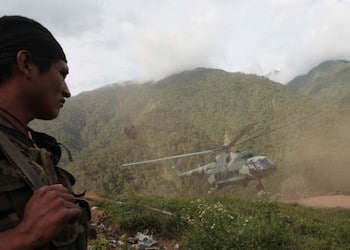A 400-page document by Peru’s Shining Path guerrillas details the group’s elaborate plans to increase drug trafficking operations and attacks on the military, which may be possible in the group’s limited stronghold. But its long-held ultimate goal — to overthrow Peru’s government — is farfetched.
During an operation at the beginning of this year, Peruvian security forces obtained the book-length document, which offers a window on an ambitious political and military strategy culminating in the 2021 Bicentennial of Peru’s independence, América Noticias reported.
SEE ALSO: Shining Path News and Profile
The document, found in the possession of a mid-level commander in the organization, was analyzed by members of the Counter-Terrorism Directorate of Peru’s National Police (Dirección de Lucha contra el Terrorismo de la Policía Nacional del Perú – DIRCOTE). According to agents, the Shining Path looks to increase its participation in drug trafficking and its use of violent tactics including killings and ambushes.
The group’s immediate objective appears to be intensifying attacks against public forces. Its medium-term objective is to regain control of territories where the group has historically had a presence. The long-term goal would be to take up arms and seize power from Peru’s government.
InSight Crime Analysis
The Shining Path has been trying to reinvent itself for years, as well as distance itself from its guerrilla history, which includes allegations of abuses committed during clashes with the state.
Following the capture of its longtime commander Abimael Guzmán in 1992 and of Florindo Eleuterio Flores, alias “Comandante Artemio,” in 2012, the Shining Path concentrated its area of influence along the Valley of the Apurímac, Ene and Mantaro Rivers (Valle de los ríos Apurímac, Ene y Mantaro – VRAEM). The group has operated under the command of the Quispe Palomino brothers since 1999.
A key step in the brothers’ vision was for the group to return under a new name, the Militarized Communist Party of Peru (Militarizado Partido Comunista del Perú – MPCP), in an effort to gain the support of rural farmer communities within the VRAEM that were victimized by the Shining Path. Additionally, they decided to label former commander Abimael Guzmán as a traitor to the movement.
The MPCP currently calls upon a small force of about 300, primarily made up of young, inexperienced fighters, now that the majority of its longtime commanders, such as alias “Alipio” and more recently alias “Leonidas,” have been captured or killed.
A narrow stretch of the VRAEM, which passes through the departments of Junín, Ayacucho and Huancavelica, is a stronghold for the group. The group is believed to fund itself primarily through securing cocaine shipments belonging to drug trafficking clans. Peru’s VRAEM has for years been among the country’s most important coca-growing regions.
The guerrilla force may also be charging rural farmers a fee for planting the coca leaf on territory under its control.
These criminal activities, however, would not provide enough resources for the group to expand into new territories.
SEE ALSO: A Glimpse into the Tactics of Peru’s Shining Path Guerrillas
Although its stated strategy for 2021 may seem ambitious, the MPCP does not represent a real threat to the Peruvian state, as it has neither the military or economic capacity to carry out its plan.
Yet Peru isn’t likely to dismantle the group in the short-term. In the past decade, authorities have been unable to drive the group out of the VRAEM.
The MPCP’s strategy is likely to simply be ‘fake it until you make it’, or feign being a stronger and more relevant organization that it currently is and to show its resiliency in the face of frequent operations by security forces.

